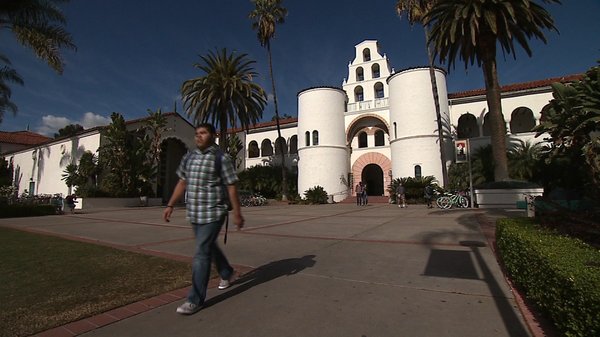 Javier Silva Ayala, 19, on his way to lunch after a morning class at San Diego State University, Dec. 4, 2013. Silva Ayala is one of 7,469 California college students who immigrated to the country illegally and now receive state-funded financial aid. | Photo Credit: Guillermo Sevilla, KPBS
Javier Silva Ayala, 19, on his way to lunch after a morning class at San Diego State University, Dec. 4, 2013. Silva Ayala is one of 7,469 California college students who immigrated to the country illegally and now receive state-funded financial aid. | Photo Credit: Guillermo Sevilla, KPBS
Haga clic aquí para leerlo en Español
Sitting in class, sophomore civil engineering major Javier Silva Ayala doesn’t seem different from any other San Diego State University student. But going to college here, just a few miles from home, was out of the question until recently.
“After high school, I was seriously thinking about moving back to Mexico to pursue higher education,” Silva Ayala said.
Silva Ayala and his parents moved San Diego’s City Heights neighborhood when he was 4 years old. They had immigrated illegally and returned to Mexico for two years when Silva Ayala was in middle school. It was his choice for the family to move back to the U.S. when he was 12, and he didn’t want to leave again.
“San Diego is my home,” he said. “I have all my friends here, all my family, so it was going to be a difficult process, just assimilating if I moved back, the language — I primarily speak English.“
Just as he started his final year of high school in 2011, California passed its Dream Act. It made the state one of just a few that allows students living in the country illegally to qualify for state financial aid. That put attending college close to home within Silva Ayala’s reach.
“It was just a relief from worrying: where am I going to go in Mexico, who am I going to stay with?” he said.
Under the California Dream Act, students like Silva Ayala, who attended high school for at least three years and graduated in the state, qualified for privately funded state scholarships beginning last year. Silva Ayala was chosen as one of 15 Price Community Scholars at SDSU, and his tuition is paid through that privately funded program.
This year, he also became one of 353 San Diego County Dream Act students to receive a publicly funded CalGrant. The supplemental grant pays for things like textbooks and living expenses. That meant Silva Ayala could give up his 16-hour-a-week landscaping job this year and focus on his classes.
“I’ve noticed in my grades how they have been improving,” he said. “It also has helped me. I can be more involved on campus. I can come on campus on the weekends and study with friends, something that last year was very difficult as a freshman. It would have helped a lot if I had the opportunity to get more involved during my freshman year.”
Getting students this kind of support is at the top of Diana Fuentes-Michel’s list of major professional accomplishments. She is executive director of the California Student Aid Commission and has been working to help students like Silva Ayala have access to higher education for more than a dozen years.
“They’ve worked and live in the United States, being in school and trying to get good grades and do the right thing. So they’re not going to go anywhere else,” Fuentes-Michel said. “So they’re either going to be very productive members of our society or they’re not, and I think that’s an economic reason why we need to consider these students as essential.”
The aid commission estimates the state will pay out $801.3 million in CalGrant awards to 173,067 students this year. The 7,469 Dream Act students receiving aid through the program are expected to get about $34.6 million, about 4.3 percent of the total.
The Dream Act’s opponents have a different economic perspective. Santee Assemblyman Brian Jones supported an effort to repeal the Dream Act last year. He believes the state needs a compassionate response to immigrants living in the state illegally but said this isn’t it.
“The resources for the UC system, the CSU system and the community colleges is limited, and we have lots of people competing for those grants and those scholarships that are here legally and can work here legally afterwards,” he said.
Silva Ayala sees that question — of what a Dream Act student can do after graduation — as one that prevents many people who now qualify for state aid from applying.
“Sometimes it may feel that if they do so, if they pursue a career here, that it will be a waste of time,” he said.
Three afternoons a week, Silva Ayala mentors and tutors three students at a City Heights middle school. He hopes Congress will pass comprehensive immigration reform by the time he graduates. But if it doesn’t, Silva Ayala’s younger, U.S.-born brothers and mentees help keep him motivated.
“I found for myself personal motivation that I can still work in my career in Mexico,” he said. “But in a sense, there really isn’t any other motivation but personal growth that I’d like to have and just to be a role model for my brothers and my mentees.”
Silva Ayala said he wants to make as much of a contribution as he can, whether it’s right here or on the other side of the border.
